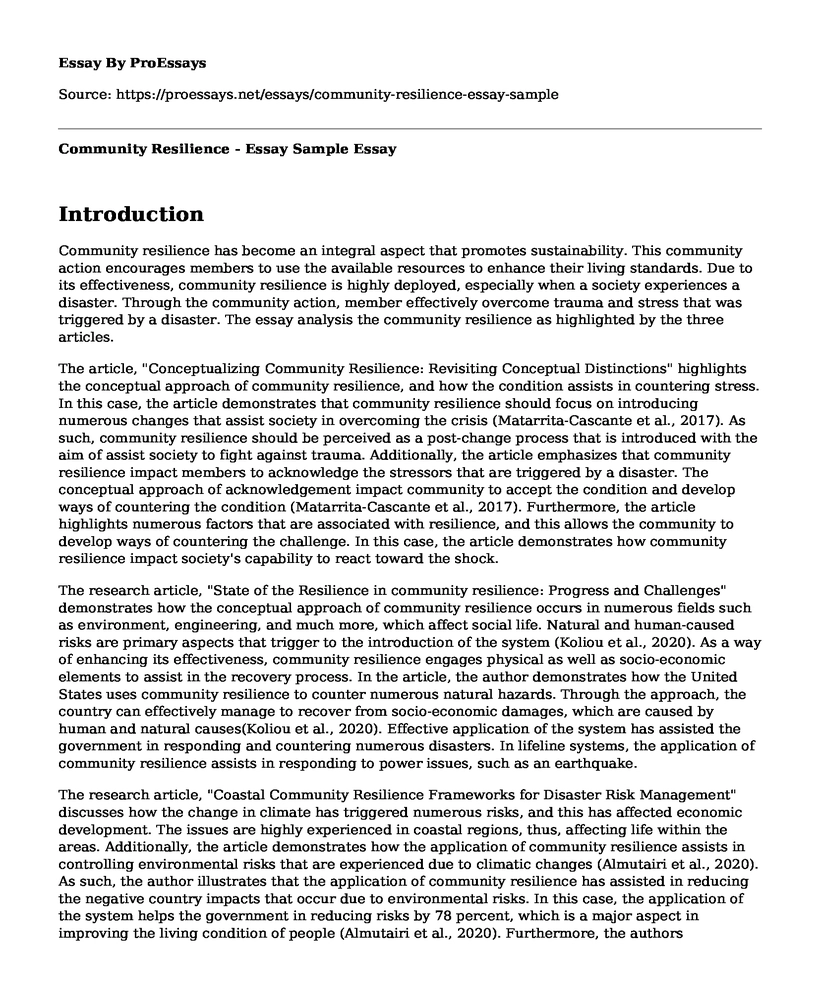Introduction
Community resilience has become an integral aspect that promotes sustainability. This community action encourages members to use the available resources to enhance their living standards. Due to its effectiveness, community resilience is highly deployed, especially when a society experiences a disaster. Through the community action, member effectively overcome trauma and stress that was triggered by a disaster. The essay analysis the community resilience as highlighted by the three articles.
The article, "Conceptualizing Community Resilience: Revisiting Conceptual Distinctions" highlights the conceptual approach of community resilience, and how the condition assists in countering stress. In this case, the article demonstrates that community resilience should focus on introducing numerous changes that assist society in overcoming the crisis (Matarrita-Cascante et al., 2017). As such, community resilience should be perceived as a post-change process that is introduced with the aim of assist society to fight against trauma. Additionally, the article emphasizes that community resilience impact members to acknowledge the stressors that are triggered by a disaster. The conceptual approach of acknowledgement impact community to accept the condition and develop ways of countering the condition (Matarrita-Cascante et al., 2017). Furthermore, the article highlights numerous factors that are associated with resilience, and this allows the community to develop ways of countering the challenge. In this case, the article demonstrates how community resilience impact society's capability to react toward the shock.
The research article, "State of the Resilience in community resilience: Progress and Challenges" demonstrates how the conceptual approach of community resilience occurs in numerous fields such as environment, engineering, and much more, which affect social life. Natural and human-caused risks are primary aspects that trigger to the introduction of the system (Koliou et al., 2020). As a way of enhancing its effectiveness, community resilience engages physical as well as socio-economic elements to assist in the recovery process. In the article, the author demonstrates how the United States uses community resilience to counter numerous natural hazards. Through the approach, the country can effectively manage to recover from socio-economic damages, which are caused by human and natural causes(Koliou et al., 2020). Effective application of the system has assisted the government in responding and countering numerous disasters. In lifeline systems, the application of community resilience assists in responding to power issues, such as an earthquake.
The research article, "Coastal Community Resilience Frameworks for Disaster Risk Management" discusses how the change in climate has triggered numerous risks, and this has affected economic development. The issues are highly experienced in coastal regions, thus, affecting life within the areas. Additionally, the article demonstrates how the application of community resilience assists in controlling environmental risks that are experienced due to climatic changes (Almutairi et al., 2020). As such, the author illustrates that the application of community resilience has assisted in reducing the negative country impacts that occur due to environmental risks. In this case, the application of the system helps the government in reducing risks by 78 percent, which is a major aspect in improving the living condition of people (Almutairi et al., 2020). Furthermore, the authors demonstrate that the application of community resilience has assisted in assuring members about enough protection against any form of threat that may occur due to environmental aspects.
Conclusion
In conclusion, community resilience is an integral aspect that the government engages in improving the lives of people after a disaster. Through this community action, people are able to effectively counter stress and trauma that occur due to a disaster. The approach helps in countering negative aspects that could be experienced when a human or natural disaster occurs.
References
Almutairi, A., Mourshed, M., & Ameen, R. F. M. (2020). Coastal community resilience frameworks for disaster risk management. Natural Hazards, 1-36. https://link.springer.com/article/10.1007/s11069-020-03875-3
Koliou, M., van de Lindt, J. W., McAllister, T. P., Ellingwood, B. R., Dillard, M., & Cutler, H. (2020). State of the research in community resilience: Progress and challenges. Sustainable and Resilient Infrastructure, 5(3), 131-151. https://www.ncbi.nlm.nih.gov/pmc/articles/PMC6508589/
Matarrita-Cascante, D., Trejos, B., Qin, H., Joo, D., & Debner, S. (2017). Conceptualizing community resilience: Revisiting conceptual distinctions. Community Development, 48(1), 105-123. https://www.tandfonline.com/doi/pdf/10.1080/15575330.2016.1248458?casa_token=0rtPKSzW5vMAAAAA:O90pwqZPRMk9pHZZvzGtJznj-BHVlrNSoO9EIt-ZujP2ieG1XHYMTELx9zIK-7ezTfcI7lnGScV52Vta
Cite this page
Community Resilience - Essay Sample. (2023, May 19). Retrieved from https://proessays.net/essays/community-resilience-essay-sample
If you are the original author of this essay and no longer wish to have it published on the ProEssays website, please click below to request its removal:
- Selective Serotonin Reuptake Inhibitors (SSRIs) Paper Example
- Essay Sample on Technology and Mental Health: Effects on Children
- Essay Sample on John Locke's Theory Of Personal Identity
- Essay Sample on Caring for People with History of Childhood Trauma
- Paper Example on True Love: Exploring Shakespeare's Iconic Sonnet 116
- Old Age & Social Participation - Report Example
- Importance of Research in Psychology - Report Example







